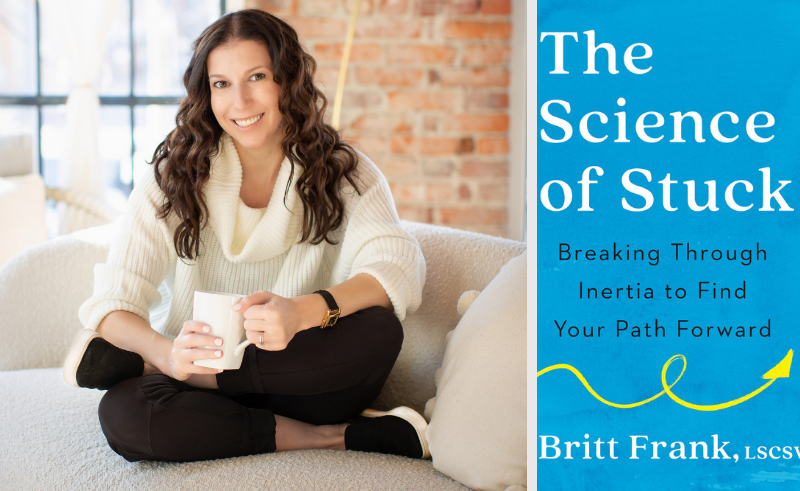
After living through the last two years of turbulent uncertainty, we could all use a healthy dose of something that makes us feel a little less crazy, a little less alone, and a little less stuck.
Thankfully, a new book published by Penguin Random House, The Science of Stuck: Breaking Through Inertia to Find Your Path Forward, written by Mission, Kansas, therapist Britt Frank, is just the tool we need to find the way to getting unstuck.
The award-winning therapist and University of Kansas adjunct professor (virtually) sat down with IN Kansas City for a Q&A about the book and tips on mental health.
This is your first book. What inspired you to start with The Science of Stuck?
I’ve always wanted to write a book, but it was really in 2017 when I looked around at all this amazing research that I had collected—the tools and books— and if I had had all this back when I started my (mental health) process that would have been really helpful. So, 2017 was when I said I have enough information here to put together the book that I could have used that, hopefully, somebody else will find useful.
How did your own experiences influence the book?
I’m an 80s kid, and I came up in the era of, ‘just think your way forward; just think positive.’ Therapy wasn’t really a thing when I grew up, and trauma was certainly never a word I heard ever—not even after going through what would certainly be considered big traumas like sexual assault, domestic violence, drug addiction, and eating disorders. I had a lot of diagnoses, and I thought that this was just who I am. A diagnosis is helpful because it helps organize all our symptoms, but I thought that my diagnosis was my identity, and it’s not true. With this book, it’s not like here’s a deep dive analysis into the neuroscience, it’s here’s driver’s ed. You don’t need to learn everything about a car in driver’s ed, you learn just enough that you can safely operate it. And with mental health, it’s the same thing.
You started this pre-pandemic, so how did the pandemic impact your writing process when it started?
When I started the project in 2017, I very quickly learned about the book publishing process—no one wants to talk to someone who doesn’t have a following or platform. So, I started writing on Instagram. Every day I posted a thought about a topic, and very quickly, people seemed to resonate with it. I had already been talking about trauma and the brain and how the external environment can shut us down, and when the pandemic hit, suddenly trauma wasn’t a niche thing anymore. Suddenly, even if you never identified as having mental health issues, or identified as a trauma survivor, the pandemic normalized mental health struggles.
One thing you say is, “what if everything we learned about mental health is wrong?” What do you mean by that?
Our pain is real. Our symptoms are real. Whatever the diagnosis, it doesn’t minimize or invalidate the problem of pain. It doesn’t change the fact that we’re in pain and hurting. So that’s my big caveat. So often, what we call a mental health disorder is a very reasonable response to our environment. And again, that doesn’t make it okay, and that doesn’t mean we should stay there. But we were taught that if you have a problem, it’s inside you, and you need to fix what’s broken. But what if the environment is what’s contributing to your symptoms? We can change that; we can do something about that. What if you’re not actually broken? There’s no such thing as a crazy person—it doesn’t exist. Everything makes sense in context.
When a person is in a spot of feeling stuck—as the title of your book suggests—what are the first steps they should take?
Step one: Say to yourself, “I am not crazy.” That little simple affirmation is so powerful because as soon as you believe that you’re crazy, everything is going to feel skewed, impossible, and overwhelming.
Step two: Don’t ask “why am I feeling like this? Why am I so messed up? Why am I so whatever?” Take the ‘why’ off the table and change it to a ‘what.’ What are my choices right now that will help me? You don’t go up to a burning building and ask why is this building on fire? You put the fire out, you get the people out.
Step three: Ask, “out of all the choices available to me, what’s one that feels like I can say yes to? What feels doable today?” Stuck turns into unstuck the second we say yes to anything.
This interview was lightly edited for context and clarity.


